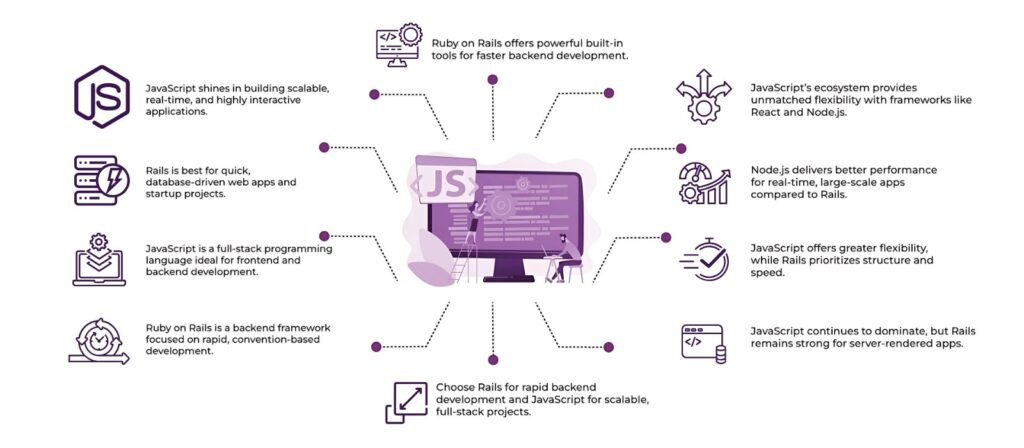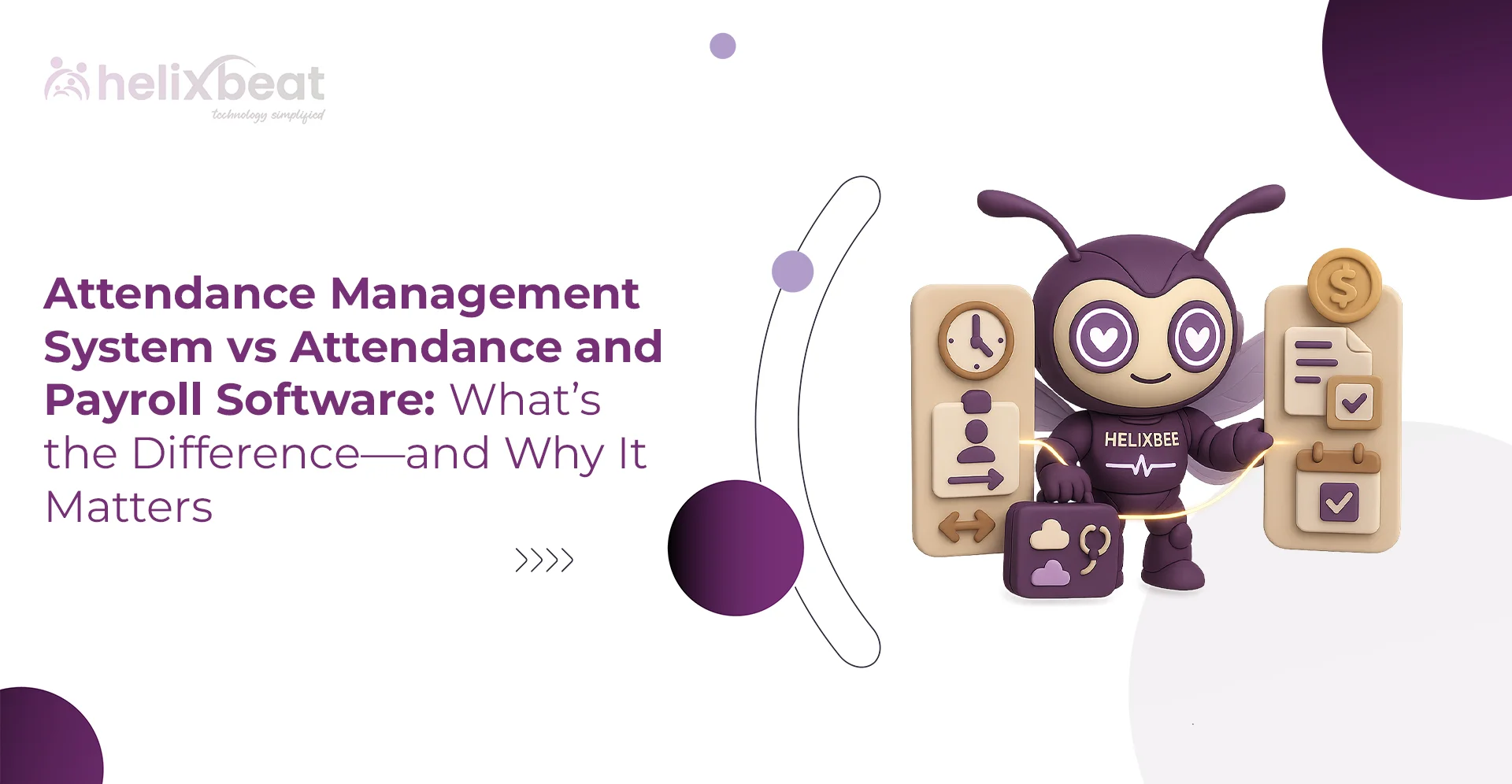As web development continues to evolve, the choice of technology plays a critical role in forming the future of applications. According to recent reports, JavaScript remains the most widely used programming language for the 9th consecutive year, with over 97% of websites utilizing JavaScript to power their frontend or backend.
On the other hand, Ruby on Rails, although not as dominant, still powers some of the most popular platforms like Shopify and GitHub and continues to be a preferred choice for rapid application development.
In 2025, developers face the challenge of choosing between two powerful web development options: Ruby on Rails and JavaScript. Whether you’re building a strong, scalable web application or a real-time, interactive platform, the technology you choose will impact development speed, performance, and future scalability.
In this article, we’ll compare Ruby on Rails and JavaScript, to help you decide which is the best fit for your project in 2025.
Table of Contents
What is Ruby on Rails?
Ruby on Rails, often referred to as Rails, is an open-source web application framework written in the Ruby programming language. It follows the Model-View-Controller (MVC) architecture, making it easier to build and maintain complex web applications. Rails highlight convention over configuration, enabling developers to create applications quickly with less code.
Rails influence over 1 million websites, including large-scale platforms like GitHub, Shopify, and Basecamp. Despite the rise of other frameworks, Rails remains a go-to choice for startups and developers looking to build efficient, scalable web apps with rapid turnaround times.

Advantages and Disadvantages of Ruby on Rails
Ruby on Rails is a popular web development framework known for its efficiency and ease of use. While it offers many benefits like rapid development and a supportive community, it also has its drawbacks, including performance limitations and reduced flexibility for complex applications.
Advantages:
- Speed of Development: Ruby on Rails allows developers to build applications rapidly thanks to its convention-based structure, built-in tools, and rich libraries.
- Simplicity: The framework’s simplicity allows developers to focus more on logic rather than repetitive code, making it an ideal choice for startups and small teams.
- Community Support: Rails has a strong, vibrant community that contributes to a wide range of libraries (gems), enabling quick and easy access to functionality such as authentication, payments, and more.
- Built-in Tools: Rails offers an extensive set of built-in tools, such as Active Record for database management, ActionView for views, and Action Controller for managing controllers.
Disadvantages:
- Performance: While Rails is great for rapid development, it may not be as performant as JavaScript-based solutions, particularly when scaling large, complex applications.
- Less Flexibility: Ruby on Rails follows specific conventions, which can limit flexibility for certain applications compared to JavaScript frameworks like Node.js.
- Learning Curve: Although Rails simplifies many aspects of development, new developers may face a learning curve when understanding Rails’ “magic” behind-the-scenes.
Future of Ruby on Rails and Its Uses Cases
The Future of Ruby on Rails:
While Rails might not be as “trendy” as newer JavaScript frameworks, it remains a powerful choice for building solid and maintainable applications.
With the growing interest in serverless architectures and microservices, Ruby on Rails is adapting to meet the demand for scalable and high-performance applications.
Uses:
Ruby on Rails is well-suited for building applications like:
- E-commerce platforms: Examples include Shopify and Spree Commerce.
- Social networks: Popular platforms like Basecamp (Rails’ creator) are built with Rails.
- Content Management Systems (CMS): Platforms like WordPress use Rails for CMS development.
What is JavaScript?
JavaScript is a high-level, dynamic programming language that enables interactive elements and functionality in web browsers. Originally designed for client-side scripting, it has grown to power both frontend and backend development, particularly with the rise of Node.js.
As of 2025, JavaScript continues to dominate the programming landscape, with over 98% of websites using it for client-side scripting, according to W3Techs. It is the most popular language in the world, with 12 million developers worldwide using it across various domains, from web development to mobile applications and server-side solutions.
Advantages and Disadvantages of JavaScript
JavaScript is a foundational language for web development, powering interactive websites and real-time applications. While it offers great flexibility, speed, and a vast ecosystem, it also presents certain challenges, especially in terms of complexity and performance in large-scale applications.
Advantages:
- Full-stack Development: JavaScript is used for both client-side and server-side development, making it possible to build entire applications using just one language.
- Performance: With Node.js, JavaScript allows developers to build fast, scalable applications that handle real-time data processing efficiently.
- Vast Ecosystem: JavaScript boasts a large and diverse ecosystem of libraries and frameworks (e.g., React, Express, Vue), making it an ideal choice for almost any type of application.
- Asynchronous Programming: JavaScript, especially with Node.js, allows asynchronous execution, making it perfect for building real-time applications like messaging platforms or live updates.
Disadvantages:
- Complexity with Asynchronous Code: While JavaScript’s asynchronous nature is powerful, it can lead to challenges in writing maintainable code, especially in large applications.
- Callback Hell: In complex applications, JavaScript’s reliance on callbacks for handling asynchronous operations can become difficult to manage and maintain.
- Inconsistent Performance: JavaScript’s performance can be inconsistent across different devices and browsers, particularly when compared to Ruby on Rails’ robust architecture.
Future of JavaScript and Its Uses Cases
The Future of JavaScript:
JavaScript is continuing to evolve, with innovations like serverless computing and edge computing pushing it forward. The rise of TypeScript, a statically typed version of JavaScript, has further solidified its position as a go-to language for developers in 2025.
Applications Built with JavaScript:
- Real-time applications: Platforms like Slack and Trello leverage JavaScript and Node.js for seamless real-time updates.
- Single-page applications (SPA): Frameworks like React and Vue.js are used to build high-performing SPAs like Facebook and Instagram.
- Enterprise applications: Many enterprises use JavaScript for building complex, scalable applications due to its flexibility and ability to handle large datasets.
JavaScript vs Ruby On Rails: 7 Key Differences
When comparing Ruby on Rails vs JavaScript, it’s important to consider how each technology excels in different areas of web development, from performance to flexibility and real-time capabilities.
| Feature | Ruby on Rails | JavaScript |
| Type | Web application framework | Programming language |
| Primary Use | Backend web development | Frontend and backend web development |
| Speed of Development | Fast due to convention over configuration | Fast for real-time apps, but may require more setup |
| Performance | Can be slower for large, real-time apps | High performance, especially with Node.js |
| Flexibility | Less flexible due to conventions | Highly flexible with many frameworks (React, Vue, Node.js) |
| Best for | Rapid prototyping and database-driven apps | Real-time apps, full-stack development, and interactive UIs |
| Real-Time Capabilities | Limited | Excellent (especially with Node.js) |
In the Ruby on Rails vs JavaScript debate, Ruby on Rails is great for building apps quickly, especially those that rely on databases. JavaScript, on the other hand, shines when building real-time applications and interactive websites.
Conclusion:
In Ruby on Rails vs JavaScript, the choice depends on your project’s needs, team experience, and scalability requirements. If you’re looking for rapid development, easy to use, and convention-driven frameworks, Ruby on Rails is a solid choice. It works best for smaller to medium-sized projects that don’t demand real-time capabilities.
However, if your project requires high performance, scalability, and a unified language for both frontend and backend, JavaScript (especially with Node.js) offers a more flexible and future-proof solution. It is ideal for real-time applications, microservices, and full-stack web applications.
Ultimately, the right choice depends on your specific needs and your team’s expertise. Consulting with experienced developers or exploring further details can help you make the best decision for your web application in 2025.
Why Choose Helixbeat for Web Development Services
What sets Helixbeat apart is our focus on your business. We work closely with you to understand your needs and goals, creating web solutions that align with your vision.
Even after your website is live, we offer ongoing support and maintenance to keep everything running smoothly. Whether it’s updates, security, or performance improvements, we’ve got you covered.
By choosing Helixbeat, you’re partnering with a team that’s dedicated to delivering user-friendly and effective web development solutions for your business.
FAQ:
1: Which is better, JavaScript or Ruby on Rails?
It depends on the project. JavaScript is better for full-stack development and real-time apps, while Ruby on Rails excels in rapid backend development for database-driven applications.
2: Can Ruby on Rails replace JavaScript?
No, Ruby on Rails can’t replace JavaScript. JavaScript is essential for frontend interactivity, while Rails is focused on backend development.
3: Is Ruby on Rails a dying language?
No, Ruby on Rails is still widely used, particularly for startups and scalable web applications. It’s not a dying language.
4: Is Ruby harder than JS?
Ruby is generally easier to learn due to its simplicity, while JavaScript can be more complex due to asynchronous programming.
5: What is Rails vs Node?
Rails is a Ruby-based framework for backend development, while Node.js is a JavaScript runtime used for building scalable, real-time applications.
6: What Should I choose: Ruby or JavaScript?
Choose Ruby on Rails for rapid backend development and JavaScript for full-stack or real-time applications.














